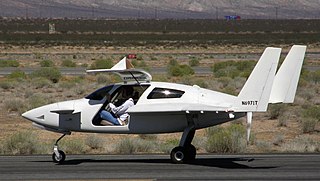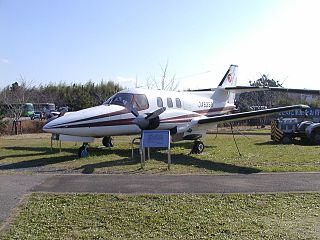
The Rutan Model 61 Long-EZ is a tandem 2-seater homebuilt aircraft designed by Burt Rutan's Rutan Aircraft Factory. The Long-EZ has a canard layout, a swept wing with wingtip rudders, and a pusher engine and propeller. The tricycle landing gear has fixed main wheels with streamlined spats and a retractable nosewheel. Its predecessor was the VariEze, plans for which were first available to homebuilders in 1976. The prototype Long-EZ, N79RA, first flew on June 12, 1979.

The Rutan VariEze is a composite, canard aircraft designed by Burt Rutan. It is a high-performance homebuilt aircraft, hundreds of which have been constructed. The design later evolved into the Long-EZ and other, larger cabin canard aircraft. The VariEze is notable for popularizing the canard configuration and moldless glass cloth composite construction for homebuilt aircraft.

The Rutan Model 54 Quickie is a lightweight single-seat taildragger aircraft of composite construction, configured with tandem wings.

The Rutan Model 40 Defiant is a four-seat, twin-engine homebuilt aircraft with the engines in a push-pull configuration. It was designed by aerospace engineer Burt Rutan for the Rutan Aircraft Factory.

The Velocity Model 173 SE (Standard Elite) is an entry level canard pusher aircraft from Velocity Aircraft. The four seat, rear engine aircraft may be powered by a 160 hp (120 kW) Lycoming IO-320 or a 200 hp (150 kW) Lycoming IO-360 engine.

The Velocity XL is an American amateur-built aircraft, produced by Velocity, Inc. It is an enlarged version of their Velocity SE canard pusher design.

The Rutan VariViggen is a homebuilt aircraft designed by Burt Rutan. The aircraft is a tandem two-seater of primarily wooden construction with a delta wing and a canard foreplane. The VariViggen is powered by a 150 hp Lycoming O-320 aero engine in pusher configuration. The prototype was designated Model 27, and the production version was Model 32.

The Cozy III is a 3-seat, single engine, homebuilt light aircraft designed by Nat Puffer. The aircraft is built from plans using basic raw materials. It is not a kit aircraft, though many small parts are available prefabricated. The Cozy is similar in design and construction to the 2-seat Rutan Long-EZ, from which it is derived, with approval from Burt Rutan.

The AMSOIL Racer, also known as the Rutan Biplane Racer and the Rutan Model 68 Racer, was a race tandem wing plane which was designed by Burt Rutan's Rutan Aircraft Factory, and built and flown by Dan Mortensen. It set several speed records, but crashed at the 1983 Reno Air Races.

The Piper Aerostar is an American twin-engined propeller-driven executive or light transport aircraft, designed by Ted R. Smith. It was originally built by Ted Smith Aircraft Company, which after 1978 became part of the Piper Aircraft Corporation.

The Fuji/Rockwell Commander 700 is a light transport aircraft which was a joint Japanese-American development between Fuji Heavy Industries and Rockwell International. When Rockwell sold off the general aviation division the agreement was terminated.

The SIAI-Marchetti S.210 was a 1970s Italian twin-engined cabin-monoplane designed and built by SIAI-Marchetti as a development of the single-engined SIAI-Marchetti S.205.

The Scaled Composites Model 81 Catbird is a high-efficiency five-seat single-engine all-composite general aviation aircraft designed by Burt Rutan. It is unusual in that it incorporates both a small forward wing and a small conventional horizontal stabilizer on the tail.

The Piper PA-35 Pocono was an American 16/18 seat commuter airliner developed by Piper in the late 1960s. Only one aircraft was built and the design was not developed.
The Sequio 300 Sequoia is an American two-seat utility or aerobatic aircraft, designed by David Thurston for Sequoia Aircraft Corporation for sale as a kit or set of plans for homebuilding.

The Trident TR-1 Trigull is a Canadian amphibious aircraft that was developed by Trident Aircraft of Burnaby, British Columbia and later Sidney, British Columbia. The aircraft was intended to be supplied as a complete ready-to-fly certified aircraft. The company encountered financial difficulties and only three prototypes were ever built.

The Van's Aircraft RV-14 is an American aerobatic kit aircraft designed by Richard VanGrunsven and produced by Van's Aircraft. It was introduced at AirVenture in July 2012. The aircraft is supplied as a kit for amateur construction.

The Ravin 500 is a South African amateur-built aircraft, designed and produced by Ravin Aircraft of Pretoria. The aircraft first flew on 15 September 2002 and is supplied as a kit for amateur construction or as a complete ready-to-fly aircraft.
The Shirlen Big Cootie is an American homebuilt biplane that was designed by Roy Shirlen.
The CEI Free Spirit Mk II, also called the Cabrinha Free Spirit Mark II and the Cabrinha Model 423, is a three-seat American homebuilt aircraft that was designed by Richard Cabrinha and produced by CEI of Auburn, California, introduced at AirVenture in 1995. The aircraft was intended to be supplied as a kit for amateur construction, but only prototypes seem to have been completed.





















